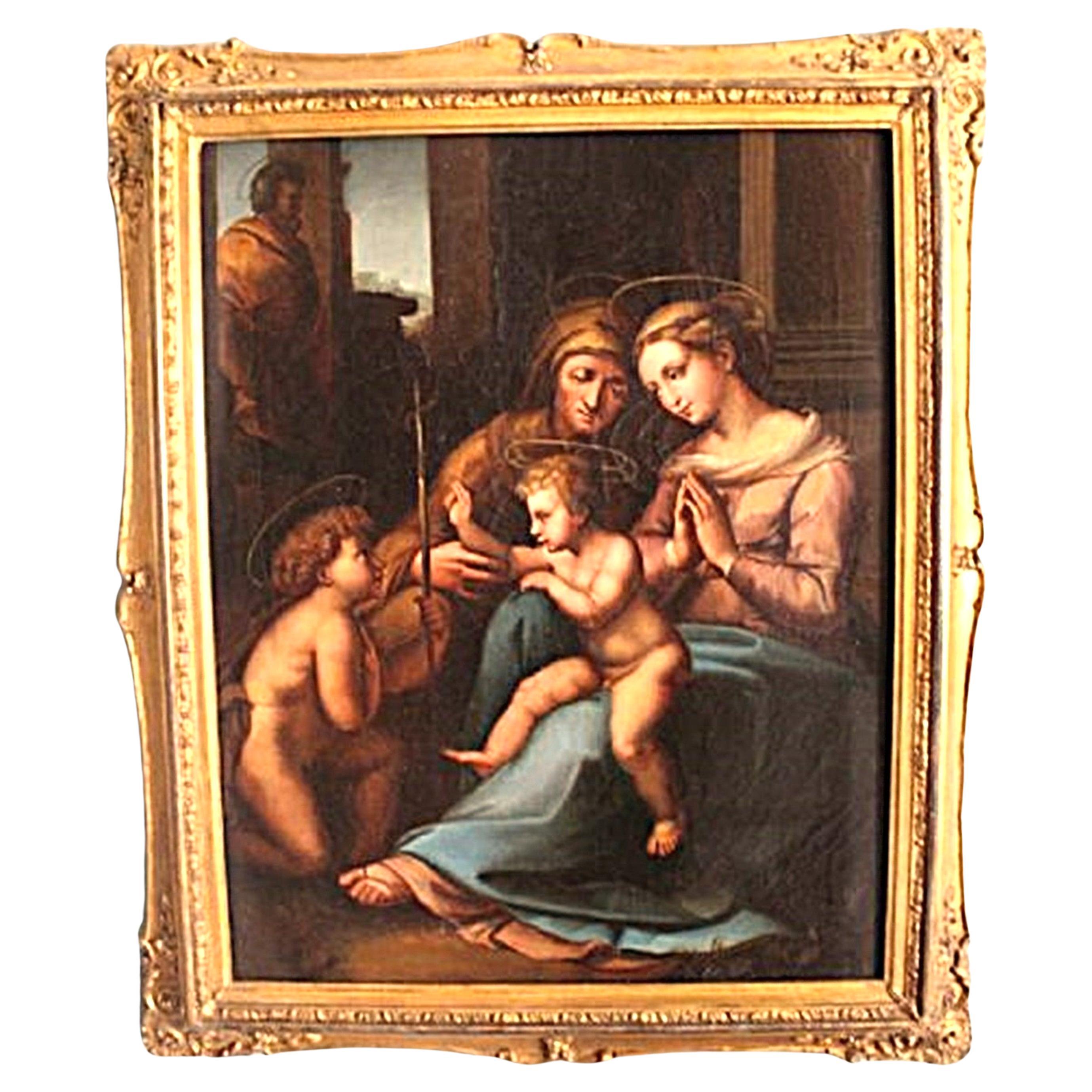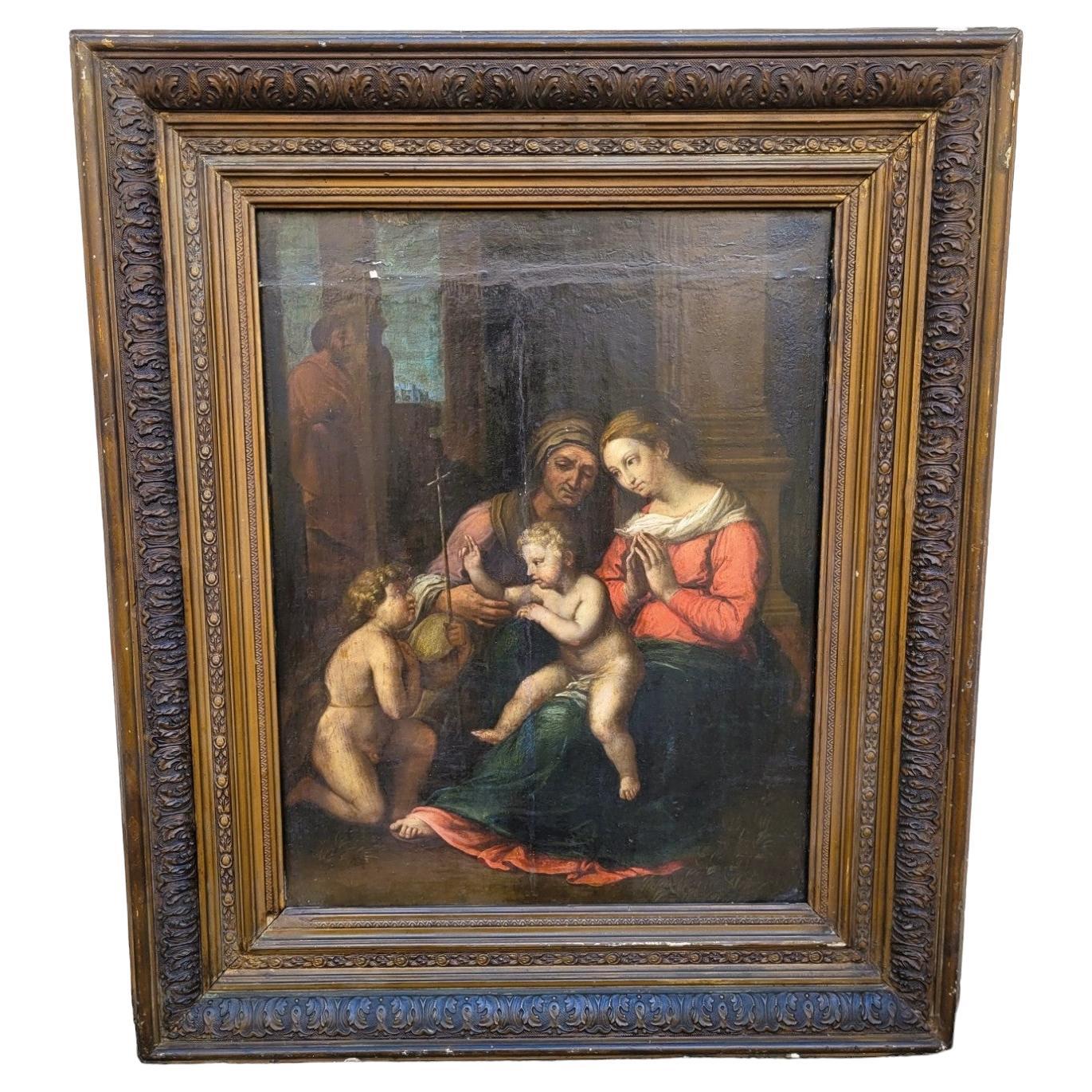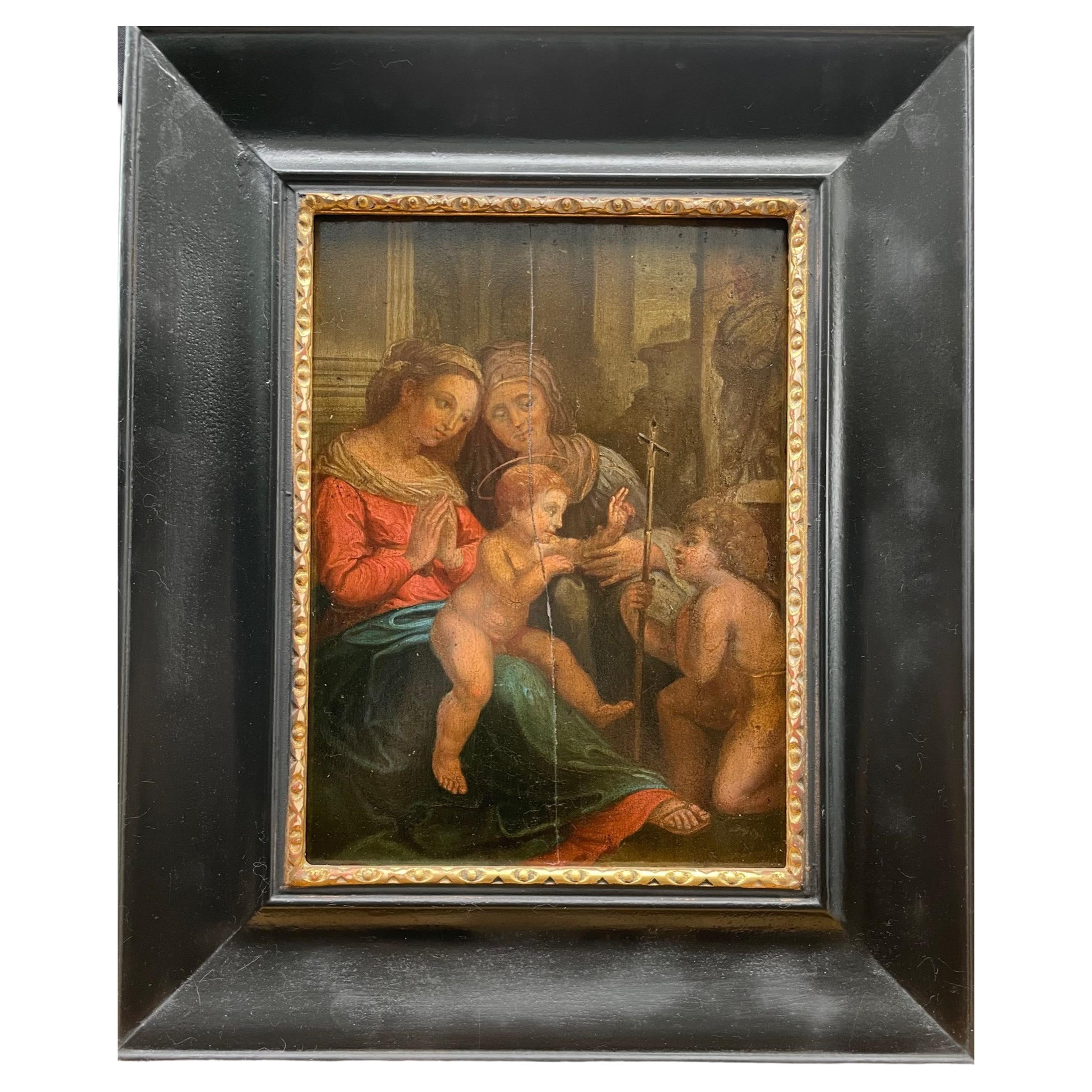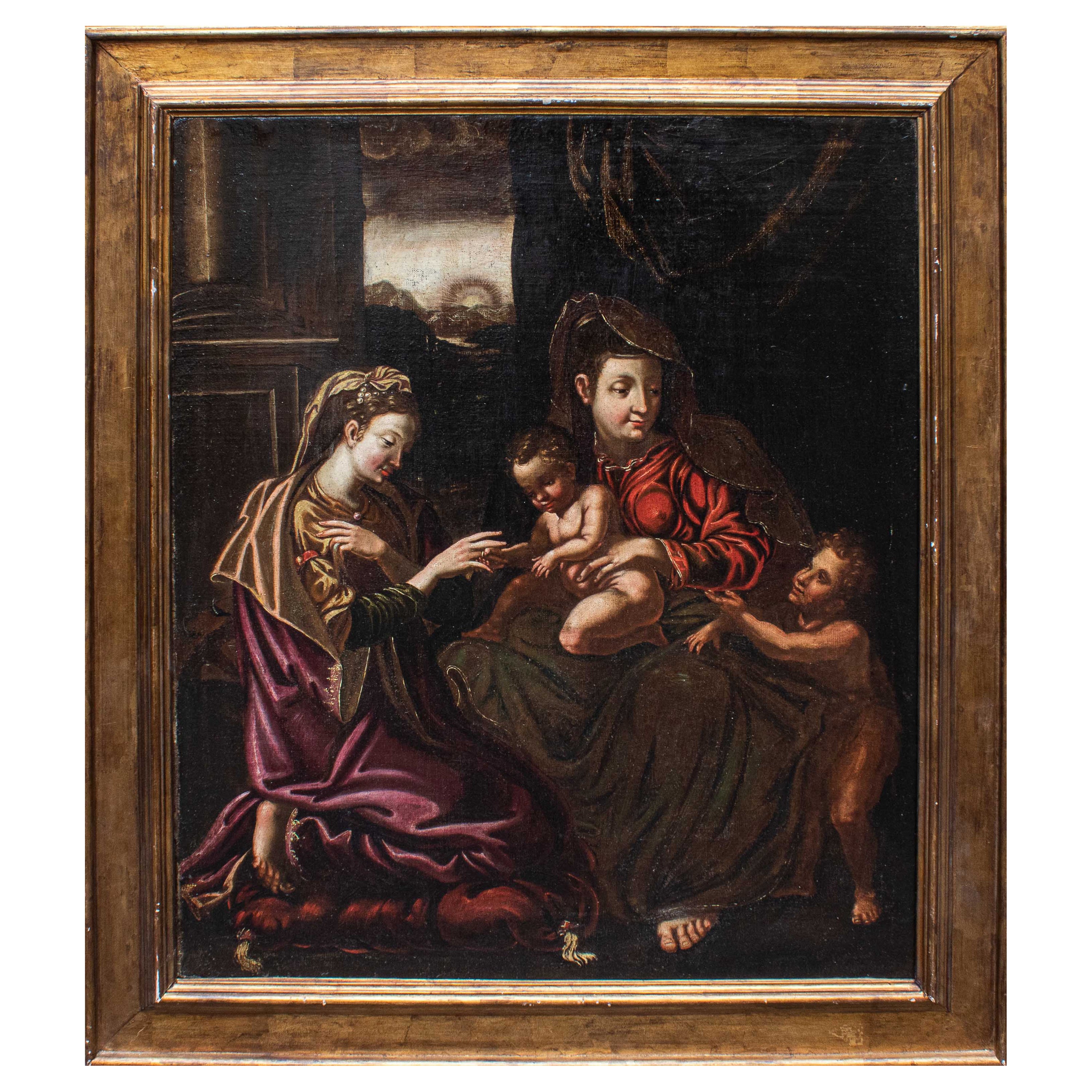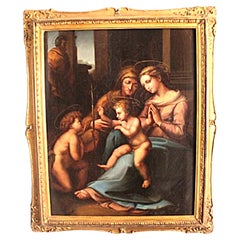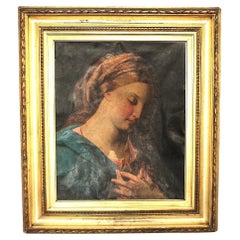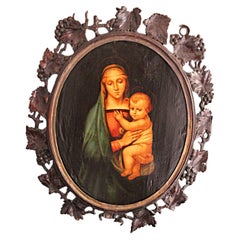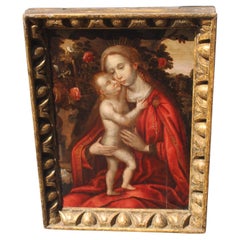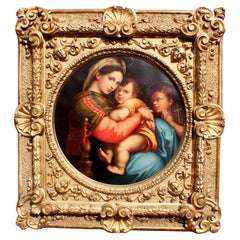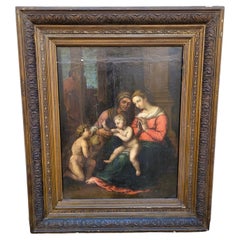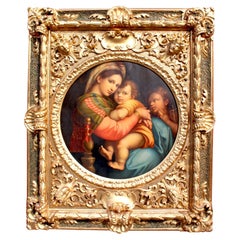Items Similar to 18th century Antonio Correggio The Mystic Marriage of St Catherine
Want more images or videos?
Request additional images or videos from the seller
1 of 11
18th century Antonio Correggio The Mystic Marriage of St Catherine
$2,395
$2,993.7520% Off
£1,760
£2,20020% Off
€2,067.71
€2,584.6320% Off
CA$3,290.32
CA$4,112.9020% Off
A$3,673.33
A$4,591.6720% Off
CHF 1,924.77
CHF 2,405.9620% Off
MX$44,965.21
MX$56,206.5220% Off
NOK 24,444.62
NOK 30,555.7820% Off
SEK 23,048.17
SEK 28,810.2220% Off
DKK 15,431.52
DKK 19,289.3920% Off
Shipping
Retrieving quote...The 1stDibs Promise:
Authenticity Guarantee,
Money-Back Guarantee,
24-Hour Cancellation
About the Item
Antonio Correggio’s The Mystic Marriage of St. Catherine
This stunning 18th-century copy draws inspiration from the masterpiece The Mystic Marriage of Saint Catherine, originally painted by Antonio Correggio and currently housed in the Museo di Capodimonte, Naples. Antonio Correggio’s The Mystic Marriage of St. Catherine exemplifies his mastery of soft chiaroscuro, harmonious composition, and deep emotional expression.
This particular copy closely resembles a larger version created by Antonio Cavallucci (1752-1895), which is displayed at Stourhead House. Other well-known copies of Correggio’s The Mystic Marriage of St. Catherine are preserved in the Hermitage Museum in Russia and the Philadelphia Museum of Art, attesting to the enduring popularity and influence of this iconic composition.
Subject and Symbolism: Antonio Correggio’s Saint Catherine Mystical Betrothal
The painting depicts the mystical marriage of Saint Catherine of Alexandria, a legendary Christian martyr. According to tradition, Saint Catherine experienced a vision in which she became the spiritual bride of Christ. In most artistic interpretations, the infant Jesus is shown placing a ring on her finger to symbolize their union. However, in this version, the connection between Christ and Catherine is portrayed through gentle touches and loving eye contact, capturing a moment of tender interaction. This choice emphasizes the emotional depth and nuanced storytelling that distinguish Antonio Correggio’s depiction of Saint Catherine.
The figures are beautifully rendered, with Saint Catherine’s serene expression and modest posture conveying devotion and humility. The Virgin Mary’s maternal gaze and Christ’s delicate hand gesture reflect the intimate, familial bonds central to the composition. These subtle details demonstrate Correggio’s mastery in evoking spirituality and human connection through refined visual language.
Medium and Technique
The painting is executed in oil on canvas, showcasing the rich, luminous colours and smooth tonal transitions characteristic of High Renaissance artistry. The painter skillfully uses light and shadow to create a sense of depth and softness, bringing the figures to life within their serene, ethereal setting.
Condition Report
The canvas has been relined and underwent restoration in the 1970s.
Fine spider-web craquelure is present across the surface, a natural sign of age.
Minor areas of overpainting are visible in the sky and on one hand.
The frame, also from the 1970s, shows minor losses.
Detailed photographs are available for a closer inspection of the painting’s condition.
Correggio's Saint Catherine painting
Antonio Correggio's The Mystic Marriage of Saint Catherine painting
Antonio Correggio Mystic Marriage of Saint Catherine
18th-century copy of Correggio’s The Mystic Marriage of St Catherine
Religious painting of Saint Catherine of Alexandria
High Renaissance oil painting inspired by Correggio
Tender gestures and mystical symbolism in religious art
Museum-quality copies in the Hermitage and the Philadelphia Museum of Art
Stourhead House artwork by Antonio Cavallucci
📜 Provenance – After Antonio Correggio, The Mystic Marriage of Saint Catherine, 18th Century
This finely rendered 18th-century oil on canvas is a rare and sophisticated copy of Antonio Correggio’s renowned The Mystic Marriage of Saint Catherine, originally housed in the Museo di Capodimonte, Naples. Executed with delicacy and reverence, the present painting reflects the enduring appeal of Correggio’s masterwork within Grand Tour-era collecting circles and ecclesiastical patronage.
The composition bears notable similarities to a version by Antonio Cavallucci (1752–1795), whose own interpretation resides at Stourhead House, and is further connected to a lineage of high-quality reproductions found in institutional collections such as the Hermitage Museum and the Philadelphia Museum of Art.
Depicting the mystical betrothal of Saint Catherine of Alexandria — a visionary scene in which the infant Christ engages in symbolic union with the saint — this work captures the emotional and compositional nuances of the original. Notable are the harmonious modelling of the figures, the chiaroscuro-inflected drapery, and the refined interplay of gesture and gaze between the Virgin, Christ, and Catherine.
Executed in oil on canvas, the painting exhibits the smooth tonal transitions and balanced spatial arrangement typical of High Renaissance and early Mannerist styles. The work was relined and professionally restored in the 1970s, with scattered overpainting in the upper sky and a hand; fine craquelure is visible across the surface, consistent with age.
Presented in a period-style frame with minor losses, this painting offers connoisseurs of sacred art a compelling opportunity to acquire a historic devotional work of notable lineage — ideal for both ecclesiastical collections and refined domestic interiors.
Buyer Information
This piece is an exceptional choice for collectors and enthusiasts of Renaissance religious art. Featuring the revered theme of Saint Catherine of Alexandria and inspired by one of Antonio Correggio’s most famous works, The Mystic Marriage of St. Catherine will enhance any classical art collection. Art buyers interested in Correggio-inspired reproductions or seeking religious-themed masterpieces will appreciate its historical significance and refined execution.
- Similar to:Antonio da Correggio (Artist)
- Dimensions:Height: 18.51 in (47 cm)Width: 14.97 in (38 cm)Depth: 1.58 in (4 cm)
- Style:Renaissance (In the Style Of)
- Materials and Techniques:
- Place of Origin:
- Period:
- Date of Manufacture:1790
- Condition:Wear consistent with age and use. spider web craquelure.
- Seller Location:Seaford, GB
- Reference Number:1stDibs: LU10376244312832
About the Seller
New to 1stDibs
Joined in the past six months.
No Reviews Yet
Vetted Professional Seller
Every seller passes strict standards for authenticity and reliability
Established in 2021
1stDibs seller since 2025
Typical response time: 1 hour
- ShippingRetrieving quote...Shipping from: Seaford, United Kingdom
- Return Policy
Authenticity Guarantee
In the unlikely event there’s an issue with an item’s authenticity, contact us within 1 year for a full refund. DetailsMoney-Back Guarantee
If your item is not as described, is damaged in transit, or does not arrive, contact us within 7 days for a full refund. Details24-Hour Cancellation
You have a 24-hour grace period in which to reconsider your purchase, with no questions asked.Vetted Professional Sellers
Our world-class sellers must adhere to strict standards for service and quality, maintaining the integrity of our listings.Price-Match Guarantee
If you find that a seller listed the same item for a lower price elsewhere, we’ll match it.Trusted Global Delivery
Our best-in-class carrier network provides specialized shipping options worldwide, including custom delivery.More From This Seller
View AllAfter Raphael The Madonna Of Divine Love oil on canvas
By (after) Raphael (Raffaello Sanzio da Urbino)
Located in Seaford, GB
Early 19th-Century Italian School Oil on Canvas – After Raphael
The Holy Family with Saint Elisabeth and the Infant Saint John the Baptist
Introduction: A Masterpiece Inspired by Rap...
Category
Antique Early 19th Century Italian Renaissance Paintings
Materials
Canvas
Studio of Pompeo Batoni, “Madonna of the Annunciation– Mid-18th Century Italian
Located in Seaford, GB
Country HouseAn exceptional mid-18th-century oil painting from the Studio of Pompeo Batoni (1708–1787), presenting a revered composition: The Madonna of the Annunciation. This rema...
Category
Antique Mid-17th Century Italian Grand Tour Paintings
Materials
Canvas
19th century After Rahael Grand Duke’s Madonna Painting
By (after) Raphael (Raffaello Sanzio da Urbino)
Located in Seaford, GB
After Raphael's Grand Duke's Madonna
Grand Duke's Madonna after Raphael, a stunning 19th-century oil painting from the renowned Berkley Collection. This remarkable artwork, inspire...
Category
Antique Late 19th Century Italian Renaissance Paintings
Materials
Paint, Paper
$1,796 Sale Price
20% Off
Flemish 16th century Madonna in a Rose Garden
Located in Seaford, GB
The Madonna and Child Oil Painting in a Rose Garden – Flemish (Ambrosius Benson School)
Late 16th Century/ Early 17th Century Flemish Oil Painting on Oak Panel
Artist & Background
This exquisite Flemish Renaissance Madonna and Child oil painting, titled Madonna and Child in a Rose Garden, is attributed to a follower of Ambrosius Benson (circa late 16th - early 17th century). Benson, originally from Lombardy, Italy, became a renowned master painter in Bruges, Flanders, in the early 1500s..
Key Features of This Madonna and Child Painting:
Period & Style – Late 16th-century Flemish School, influenced by Gerard David and Leonardo da Vinci.
Medium – Oil on oak panel, a signature technique of Flemish masters.
Composition – The Virgin Mary and Christ Child are set in a serene rose garden, symbolising purity and divine love.
Influence – This artwork reflects both Netherlandish precision and Lombard artistic traditions.
Provenance & Demand: Benson’s followers were widely sought after, and his compositions commanded high market value among collectors.
Antique Hand-Carved Frame Old Master Madonna and Child Artwork
This painting is housed in an original 17th-century hand-carved wooden frame featuring a classic egg-and-dart motif.
Condition Report
Conservation Status: Professionally cleaned.
Historical Cracking: Some age-related panel cracks are common in antique oil paintings.
Restoration: Minor retouching to the Madonna’s face, enhancing original details.
Why Invest in Flemish Renaissance Art?
Historical Significance – Works by Ambrosius Benson’s followers remain highly collectable in the art market.
Museum-Quality Piece – Suitable for private collectors, investors, and art connoisseurs.
European Heritage – A fine example of an Old Master religious painting...
Category
Antique 1610s Belgian Renaissance Paintings
Materials
Oak, Paint
Antique Venetian capriccio oil painting
Located in Seaford, GB
Francesco Guardi Venice Oil Painting – Venetian Art in the Manner of Guardi
Exquisite 19th-Century Venetian Oil Painting
Experience the timeless elegance of Venetian art with this r...
Category
Early 20th Century Paintings
Materials
Pine, Paint
$1,687 Sale Price
20% Off
17th Century Italian Crucifixion Painting – Oil on Panel, Baroque Devotional Art
Located in Seaford, GB
17th Century Italian School Crucifixion Oil on Panel
This exquisite 17th-century Italian School Crucifixion oil painting is a masterpiece of...
Category
Antique 17th Century Italian Baroque Paintings
Materials
Oak, Paint
$5,100 Sale Price
20% Off
You May Also Like
After Raffaello Sanzio 1483-1520 Raphael La Madonna Della Seggiola Oil on Canvas
By (after) Raphael (Raffaello Sanzio da Urbino)
Located in Los Angeles, CA
A fine Italian 19th century oil painting on canvas "La Madonna della Seggiola" after Raphael (Raffaello Sanzio da Urbino 1483-1520). The circular painted canvas depicting a seated Ma...
Category
Antique Late 19th Century Italian Baroque Paintings
Materials
Canvas, Giltwood
$21,950 Sale Price
33% Off
Italian School, Madonna Of Divine Love, On Panel, 17th/18th Century
Located in MARSEILLE, FR
Italian school 17th / 18th century: oil on framed panel, representing The Virgin and Child Jesus, accompanied by Saint Elizabeth and John the Baptist as a child, in the foreground
A...
Category
Antique Late 17th Century Italian Renaissance Paintings
Materials
Paint
17th C. Italian Old Master Painting Madonna, Child, St. Anne, John the Baptist
Located in Vero Beach, FL
17th century Italian old master painting Madonna and Child with St. Anne and St. John the Baptist.
Important Tuscan School Old Master painting in oil on a hand shaved wood panel. ...
Category
Antique Late 17th Century Italian Baroque Paintings
Materials
Wood, Paint
After Raffaello Sanzio 1483-1520 Raphael La Madonna della Seggiola Oil on Canvas
By (after) Raphael (Raffaello Sanzio da Urbino)
Located in Los Angeles, CA
A Fine Italian 19th Century Oil Painting on Canvas "La Madonna della Seggiola" after Raphael (Raffaello Sanzio da Urbino 1483-1520). The circular painted canvas depicting a seated Madonna holding an infant Jesus Christ next to a child Saint John the Baptist, all within a massive carved two-tone gilt wood, gilt-patinated and gesso frame, which is identical to the frame on Raphael's original artwork. This painting is a 19th Century copy of Raphael's Madonna della Seggiola painted in 1514 and currently exhibited and part of the permanent collection at the Palazzo Pitti, Galleria Palatina, Florence, Italy. The bodies of the Virgin, Christ, and the boy Baptist fill the whole picture. The tender, natural looking embrace of the Mother and Child, and the harmonious grouping of the figures in the round, have made this one of Raphael's most popular Madonnas. The isolated chair leg is reminiscent of papal furniture, which has led to the assumption that Leo X himself commissioned the painting. Circa: 1890-1900.
Subject: Religious painting
Painting diameter: 28 inches (71.1 cm)
Frame height: 55 1/8 inches (140 cm)
Frame width: 46 inches (116.8 cm)
Frame depth: 5 1/8 inches (13 cm)
Raffaello Sanzio da Urbino (Italian, March 28 or April 6, 1483 - April 6, 1520), known as Raphael, was an Italian painter and architect of the High Renaissance. His work is admired for its clarity of form, ease of composition, and visual achievement of the Neoplatonic ideal of human grandeur. Together with Michelangelo and Leonardo da Vinci, he forms the traditional trinity of great masters of that period.
Raphael was enormously productive, running an unusually large workshop and, despite his death at 37, leaving a large body of work. Many of his works are found in the Vatican Palace, where the frescoed Raphael Rooms were the central, and the largest, work of his career. The best known work is The School of Athens in the Vatican Stanza della Segnatura. After his early years in Rome much of his work was executed by his workshop from his drawings, with considerable loss of quality. He was extremely influential in his lifetime, though outside Rome his work was mostly known from his collaborative printmaking.
After his death, the influence of his great rival Michelangelo was more widespread until the 18th and 19th centuries, when Raphael's more serene and harmonious qualities were again regarded as the highest models. His career falls naturally into three phases and three styles, first described by Giorgio Vasari: his early years in Umbria, then a period of about four years (1504–1508) absorbing the artistic traditions of Florence, followed by his last hectic and triumphant twelve years in Rome, working for two Popes and their close associates.
Raphael was born in the small but artistically significant central Italian city of Urbino in the Marche region, where his father Giovanni Santi was court painter to the Duke. The reputation of the court had been established by Federico III da Montefeltro, a highly successful condottiere who had been created Duke of Urbino by the Pope - Urbino formed part of the Papal States - and who died the year before Raphael was born. The emphasis of Federico's court was rather more literary than artistic, but Giovanni Santi was a poet of sorts as well as a painter, and had written a rhymed chronicle of the life of Federico, and both wrote the texts and produced the decor for masque-like court entertainments. His poem to Federico shows him as keen to show awareness of the most advanced North Italian painters, and Early Netherlandish artists as well. In the very small court of Urbino he was probably more integrated into the central circle of the ruling family than most court painters.
Federico was succeeded by his son Guidobaldo da Montefeltro, who married Elisabetta Gonzaga, daughter of the ruler of Mantua, the most brilliant of the smaller Italian courts for both music and the visual arts. Under them, the court continued as a centre for literary culture. Growing up in the circle of this small court gave Raphael the excellent manners and social skills stressed by Vasari. Court life in Urbino at just after this period was to become set as the model of the virtues of the Italian humanist court through Baldassare Castiglione's depiction of it in his classic work The Book of the Courtier, published in 1528. Castiglione moved to Urbino in 1504, when Raphael was no longer based there but frequently visited, and they became good friends. He became close to other regular visitors to the court: Pietro Bibbiena and Pietro Bembo, both later cardinals, were already becoming well known as writers, and would be in Rome during Raphael's period there. Raphael mixed easily in the highest circles throughout his life, one of the factors that tended to give a misleading impression of effortlessness to his career. He did not receive a full humanistic education however; it is unclear how easily he read Latin.
Early Life and Works
His mother Màgia died in 1491 when Raphael was eight, followed on August 1, 1494 by his father, who had already remarried. Raphael was thus orphaned at eleven; his formal guardian became his only paternal uncle Bartolomeo, a priest, who subsequently engaged in litigation with his stepmother. He probably continued to live with his stepmother when not staying as an apprentice with a master. He had already shown talent, according to Vasari, who says that Raphael had been "a great help to his father". A self-portrait drawing from his teenage years shows his precocity. His father's workshop continued and, probably together with his stepmother, Raphael evidently played a part in managing it from a very early age. In Urbino, he came into contact with the works of Paolo Uccello, previously the court painter (d. 1475), and Luca Signorelli, who until 1498 was based in nearby Città di Castello.
According to Vasari, his father placed him in the workshop of the Umbrian master Pietro Perugino as an apprentice "despite the tears of his mother". The evidence of an apprenticeship comes only from Vasari and another source, and has been disputed—eight was very early for an apprenticeship to begin. An alternative theory is that he received at least some training from Timoteo Viti, who acted as court painter in Urbino from 1495.Most modern historians agree that Raphael at least worked as an assistant to Perugino from around 1500; the influence of Perugino on Raphael's early work is very clear: "probably no other pupil of genius has ever absorbed so much of his master's teaching as Raphael did", according to Wölfflin. Vasari wrote that it was impossible to distinguish between their hands at this period, but many modern art historians claim to do better and detect his hand in specific areas of works by Perugino or his workshop. Apart from stylistic closeness, their techniques are very similar as well, for example having paint applied thickly, using an oil varnish medium, in shadows and darker garments, but very thinly on flesh areas. An excess of resin in the varnish often causes cracking of areas of paint in the works of both masters. The Perugino workshop was active in both Perugia and Florence, perhaps maintaining two permanent branches. Raphael is described as a "master", that is to say fully trained, in December 1500.
His first documented work was the Baronci altarpiece for the church of Saint Nicholas of Tolentino in Città di Castello, a town halfway between Perugia and Urbino. Evangelista da Pian di Meleto, who had worked for his father, was also named in the commission. It was commissioned in 1500 and finished in 1501; now only some cut sections and a preparatory drawing remain. In the following years he painted works for other churches there, including the Mond Crucifixion (about 1503) and the Brera Wedding of the Virgin (1504), and for Perugia, such as the Oddi Altarpiece. He very probably also visited Florence in this period. These are large works, some in fresco, where Raphael confidently marshals his compositions in the somewhat static style of Perugino. He also painted many small and exquisite cabinet paintings in these years, probably mostly for the connoisseurs in the Urbino court, like the Three Graces and St. Michael, and he began to paint Madonnas and portraits. In 1502 he went to Siena at the invitation of another pupil of Perugino, Pinturicchio, "being a friend of Raphael and knowing him to be a draughtsman of the highest quality" to help with the cartoons, and very likely the designs, for a fresco series in the Piccolomini Library in Siena Cathedral. He was evidently already much in demand even at this early stage in his career.
Influence of Florence
Raphael led a "nomadic" life, working in various centres in Northern Italy, but spent a good deal of time in Florence, perhaps from about 1504. Although there is traditional reference to a "Florentine period...
Category
Antique Early 1900s Italian Baroque Paintings
Materials
Canvas, Giltwood
$19,880 Sale Price
20% Off
17th Century Mystical Marriage of Saint Catherine Painting Oil on Canvas
Located in Milan, IT
17th century
Mystical marriage of Saint Catherine
Measures: Oil on canvas, 98 x 81 cm - with frame 119 x 102 cm
The scene represents the mystical marriage between Catherine of A...
Category
Antique 17th Century Italian Paintings
Materials
Canvas
After Raffaello Sanzio 1483-1520 Raphael La Madonna della Seggiola Oil on Canvas
By (after) Raphael (Raffaello Sanzio da Urbino)
Located in Los Angeles, CA
A Fine Italian 19th Century Oil Painting on Canvas "La Madonna della Seggiola" after Raphael (Raffaello Sanzio da Urbino 1483-1520). The circular painted canvas depicting a seated Madonna holding an infant Jesus Christ next to a child Saint John the Baptist, all within a massive carved gilt wood and gesso frame, which is identical to the frame on Raphael's original artwork. This painting is a 19th Century copy of Raphael's Madonna della Seggiola painted in 1514 and currently exhibited and part of the permanent collection at the Palazzo Pitti, Galleria Palatina, Florence, Italy. The bodies of the Virgin, Christ, and the boy Baptist fill the whole picture. The tender, natural looking embrace of the Mother and Child, and the harmonious grouping of the figures in the round, have made this one of Raphael's most popular Madonnas. The isolated chair leg is reminiscent of papal furniture, which has led to the assumption that Leo X himself commissioned the painting. A retailer's label reads " Fred K/ Keer's Sons - Framers and Fine Art Dealers - 917 Broad St. Newark, N.J." - Another label from the gilder reads "Carlo Bartolini - Doratore e Verniciatori - Via Maggio 1924 - Firenze". Circa: 1890-1900.
Subject: Religious painting
Canvas diameter: 28 inches (71.1 cm)
Frame height: 54 inches (137.2 cm)
Frame width: 42 1/2 inches (108 cm)
Frame depth: 5 1/2 inches (14 cm)
Raffaello Sanzio da Urbino (Italian, March 28 or April 6, 1483 - April 6, 1520), known as Raphael, was an Italian painter and architect of the High Renaissance. His work is admired for its clarity of form, ease of composition, and visual achievement of the Neoplatonic ideal of human grandeur. Together with Michelangelo and Leonardo da Vinci, he forms the traditional trinity of great masters of that period.
Raphael was enormously productive, running an unusually large workshop and, despite his death at 37, leaving a large body of work. Many of his works are found in the Vatican Palace, where the frescoed Raphael Rooms were the central, and the largest, work of his career. The best known work is The School of Athens in the Vatican Stanza della Segnatura. After his early years in Rome much of his work was executed by his workshop from his drawings, with considerable loss of quality. He was extremely influential in his lifetime, though outside Rome his work was mostly known from his collaborative printmaking.
After his death, the influence of his great rival Michelangelo was more widespread until the 18th and 19th centuries, when Raphael's more serene and harmonious qualities were again regarded as the highest models. His career falls naturally into three phases and three styles, first described by Giorgio Vasari: his early years in Umbria, then a period of about four years (1504–1508) absorbing the artistic traditions of Florence, followed by his last hectic and triumphant twelve years in Rome, working for two Popes and their close associates.
Raphael was born in the small but artistically significant central Italian city of Urbino in the Marche region, where his father Giovanni Santi was court painter to the Duke. The reputation of the court had been established by Federico III da Montefeltro, a highly successful condottiere who had been created Duke of Urbino by the Pope - Urbino formed part of the Papal States - and who died the year before Raphael was born. The emphasis of Federico's court was rather more literary than artistic, but Giovanni Santi was a poet of sorts as well as a painter, and had written a rhymed chronicle of the life of Federico, and both wrote the texts and produced the decor for masque-like court entertainments. His poem to Federico shows him as keen to show awareness of the most advanced North Italian painters, and Early Netherlandish artists as well. In the very small court of Urbino he was probably more integrated into the central circle of the ruling family than most court painters.
Federico was succeeded by his son Guidobaldo da Montefeltro, who married Elisabetta Gonzaga, daughter of the ruler of Mantua, the most brilliant of the smaller Italian courts for both music and the visual arts. Under them, the court continued as a centre for literary culture. Growing up in the circle of this small court gave Raphael the excellent manners and social skills stressed by Vasari. Court life in Urbino at just after this period was to become set as the model of the virtues of the Italian humanist court through Baldassare Castiglione's depiction of it in his classic work The Book of the Courtier, published in 1528. Castiglione moved to Urbino in 1504, when Raphael was no longer based there but frequently visited, and they became good friends. He became close to other regular visitors to the court: Pietro Bibbiena and Pietro Bembo, both later cardinals, were already becoming well known as writers, and would be in Rome during Raphael's period there. Raphael mixed easily in the highest circles throughout his life, one of the factors that tended to give a misleading impression of effortlessness to his career. He did not receive a full humanistic education however; it is unclear how easily he read Latin.
Early Life and Works
His mother Màgia died in 1491 when Raphael was eight, followed on August 1, 1494 by his father, who had already remarried. Raphael was thus orphaned at eleven; his formal guardian became his only paternal uncle Bartolomeo, a priest, who subsequently engaged in litigation with his stepmother. He probably continued to live with his stepmother when not staying as an apprentice with a master. He had already shown talent, according to Vasari, who says that Raphael had been "a great help to his father". A self-portrait drawing from his teenage years shows his precocity. His father's workshop continued and, probably together with his stepmother, Raphael evidently played a part in managing it from a very early age. In Urbino, he came into contact with the works of Paolo Uccello, previously the court painter (d. 1475), and Luca Signorelli, who until 1498 was based in nearby Città di Castello.
According to Vasari, his father placed him in the workshop of the Umbrian master Pietro Perugino as an apprentice "despite the tears of his mother". The evidence of an apprenticeship comes only from Vasari and another source, and has been disputed—eight was very early for an apprenticeship to begin. An alternative theory is that he received at least some training from Timoteo Viti, who acted as court painter in Urbino from 1495.Most modern historians agree that Raphael at least worked as an assistant to Perugino from around 1500; the influence of Perugino on Raphael's early work is very clear: "probably no other pupil of genius has ever absorbed so much of his master's teaching as Raphael did", according to Wölfflin. Vasari wrote that it was impossible to distinguish between their hands at this period, but many modern art historians claim to do better and detect his hand in specific areas of works by Perugino or his workshop. Apart from stylistic closeness, their techniques are very similar as well, for example having paint applied thickly, using an oil varnish medium, in shadows and darker garments, but very thinly on flesh areas. An excess of resin in the varnish often causes cracking of areas of paint in the works of both masters. The Perugino workshop was active in both Perugia and Florence, perhaps maintaining two permanent branches. Raphael is described as a "master", that is to say fully trained, in December 1500.
His first documented work was the Baronci altarpiece for the church of Saint Nicholas of Tolentino in Città di Castello, a town halfway between Perugia and Urbino. Evangelista da Pian di Meleto, who had worked for his father, was also named in the commission. It was commissioned in 1500 and finished in 1501; now only some cut sections and a preparatory drawing remain. In the following years he painted works for other churches there, including the Mond Crucifixion (about 1503) and the Brera Wedding of the Virgin (1504), and for Perugia, such as the Oddi Altarpiece. He very probably also visited Florence in this period. These are large works, some in fresco, where Raphael confidently marshals his compositions in the somewhat static style of Perugino. He also painted many small and exquisite cabinet paintings in these years, probably mostly for the connoisseurs in the Urbino court, like the Three Graces and St. Michael, and he began to paint Madonnas and portraits. In 1502 he went to Siena at the invitation of another pupil of Perugino, Pinturicchio, "being a friend of Raphael and knowing him to be a draughtsman of the highest quality" to help with the cartoons, and very likely the designs, for a fresco series in the Piccolomini Library in Siena Cathedral. He was evidently already much in demand even at this early stage in his career.
Influence of Florence
Raphael led a "nomadic" life, working in various centres in Northern Italy, but spent a good deal of time in Florence, perhaps from about 1504. Although there is traditional reference to a "Florentine period...
Category
Antique Early 1900s Italian Baroque Paintings
Materials
Canvas, Giltwood
$21,950 Sale Price
33% Off
More Ways To Browse
Italian Religious Icon
Renaissance Style Ring
Christ Ring
19th Century Russian Ring
18th Century Russian Icon
Russian Icon Religious Painting
18th 19th Jesus
Will Martyr
Ecclesiastical Ring
Grand Tour Photographs
Oak Altar
Painted Demilune Cabinet
Painted Miniatures Dog
Paul Jouve
Petal Kyoto
Porcelain Cameo
Porthole Table
Primitive Jewelry
